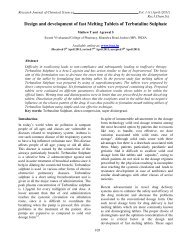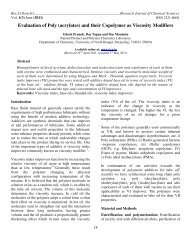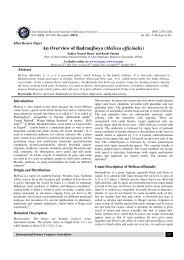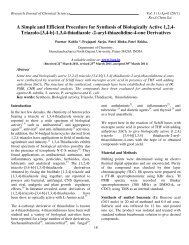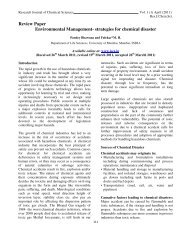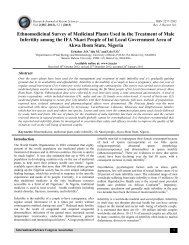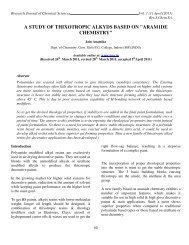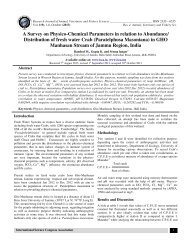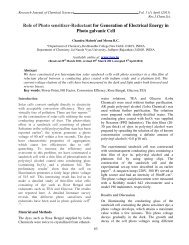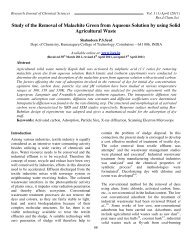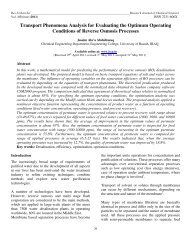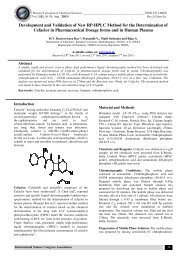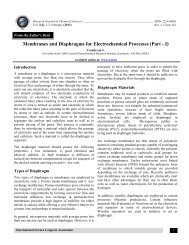Preliminary Phytochemical Analysis of some Plant Seeds - ISCA
Preliminary Phytochemical Analysis of some Plant Seeds - ISCA
Preliminary Phytochemical Analysis of some Plant Seeds - ISCA
You also want an ePaper? Increase the reach of your titles
YUMPU automatically turns print PDFs into web optimized ePapers that Google loves.
Res.J.Chem.Sci._____________________________________________Research Journal <strong>of</strong> Chemical Sciences<br />
Vol. 1(3) June (2011) ISSN 2231-606X<br />
Abstract<br />
<strong>Preliminary</strong> <strong>Phytochemical</strong> <strong>Analysis</strong> <strong>of</strong> <strong>some</strong> <strong>Plant</strong> <strong>Seeds</strong><br />
Ajayi I. A., Ajibade O. and Oderinde R. A.<br />
Industrial Unit, Chemistry Department, Faculty <strong>of</strong> Science, University <strong>of</strong> Ibadan, Ibadan, NIGERIA<br />
Available online at: www.isca.in<br />
(Received 26 th April 2011, accepted 31 st April 2011)<br />
The screening and study <strong>of</strong> seven different plant specimens belonging to different families for<br />
phytochemical constituents was performed using generally accepted laboratory technique for qualitative<br />
determinations. The constituents screened for were tannins, saponins, phlobotannins, terpenoids,<br />
flavonoids, cardiac glycosides, combined anthraquinone, free-anthraquinone, carotenoids, steroids,<br />
reducing compounds and alkaloids. The distribution <strong>of</strong> these constituents in the plant specimens were<br />
assessed and compared. The plant seeds studied were Artocarpus communis, Artocarpus heterophyllus,<br />
Calophyllum inophyllum, Garcinia kola, Garcinia mangostana, Pentaclethra macrophylla and Treculia<br />
africana. All the plant specimens were found to contain flavonoids and reducing compounds but none <strong>of</strong><br />
them contain phlobatanin, cardiac glycoside, combined anthraquinone, free anthraquinone, carotenoid<br />
and steroids. They also contain tannins (except Artocarpus communis), saponins (except Artocarpus<br />
heterophyllus) and terpenoids (except Artocarpus communis). Alkaloids were found in four out the seven<br />
specimens. Some <strong>of</strong> the plant seeds seemed to have potential as source <strong>of</strong> useful drugs.<br />
Key Words: <strong>Plant</strong> seeds, screening, phytochemical, constituents<br />
Introduction<br />
Naturally occurring substances are <strong>of</strong> plants,<br />
animals and mineral origin. They are organic<br />
substances and could be obtained in both primary<br />
and secondary metabolic process; they also provide<br />
a source <strong>of</strong> medicine since the earliest time. The<br />
plant kingdom has proven to be the most useful in<br />
the treatment <strong>of</strong> diseases and they provide an<br />
important source <strong>of</strong> all the world’s pharmaceuticals.<br />
The most important <strong>of</strong> these bioactive constituents<br />
<strong>of</strong> plants are steroids, terpenoids, carotenoids,<br />
flavanoids, alkaloids, tannins and glycosides.<br />
<strong>Plant</strong>s in all facet <strong>of</strong> life have served a valuable<br />
starting material for drug development 1 . Antibiotics<br />
or antimicrobial substances like saponins,<br />
glycosides, flavonoids and alkaloids etc are found to<br />
be distributed in plants, yet these compounds were<br />
not well established due to the lack <strong>of</strong> knowledge<br />
and techniques 2 . The phytoconstituents which are<br />
phenols, anthraquinones, alkaloids, glycosides,<br />
flavonoids and saponins are antibiotic principles <strong>of</strong><br />
plants. From these phytoconstituents, saponins have<br />
been reported to exhibit hemolytic and foaming<br />
activity 3 , antifungal 4 , anti-inflammatory 5 ,<br />
fungistatic 6 , molluscidal 7 .<br />
<strong>Plant</strong>s are now occupying important position in<br />
allopathic medicine, herbal medicine, homoeopathy<br />
and aromatherapy. Medicinal plants are the sources<br />
<strong>of</strong> many important drugs <strong>of</strong> the modern world.<br />
Many <strong>of</strong> these indigenous medicinal plants are used<br />
as spices and food plants; they are also <strong>some</strong>times<br />
added to foods meant for pregnant mothers for<br />
medicinal purposes 8,9 . Many plants are cheaper and<br />
more accessible to most people especially in the<br />
developing countries than orthodox medicine, and<br />
there is lower incidence <strong>of</strong> adverse effects after use.<br />
These reasons might account for their worldwide<br />
attention and use 10 . The medicinal properties <strong>of</strong><br />
<strong>some</strong> plants have been documented by <strong>some</strong><br />
researchers 11,12,13 . This study looks into the<br />
fundamental scientific bases for the use <strong>of</strong> <strong>some</strong><br />
medicinal plant seeds by determining the crude<br />
phytochemical constituents present in these plants.<br />
58
Res.J.Chem.Sci._____________________________________________Research Journal <strong>of</strong> Chemical Sciences<br />
Vol. 1(3) June (2011) ISSN 2231-606X<br />
Materials and Methods<br />
<strong>Plant</strong> specimen and collection: The fresh seeds <strong>of</strong><br />
Artocarpus communis, Artocarpus heterophyllus,<br />
Calophyllum inophyllum, Garcinia kola, Garcinia<br />
mangostana, Pentaclethra macrophylla and Treculia<br />
africana were collected from Botanical Garden,<br />
University <strong>of</strong> Ibadan, Oyo State. The plants were<br />
identified and authenticated at Herbarium Unit <strong>of</strong><br />
Botany Department, University <strong>of</strong> Ibadan. The fresh<br />
seeds were air dried at room temperature until dried.<br />
The dried plant seeds were blended using a blender<br />
and stored in a clean glass ware container until<br />
needed for analysis. The extracts were filtered<br />
using Whatmann filtered paper no. 42 (125 mm).<br />
<strong>Phytochemical</strong> screening: Chemical test were<br />
carried out on the aqueous extract and on the<br />
powdered specimen using standard procedure to<br />
identify the constituents as described by Mojab et<br />
al. 14 Harborne 15 , S<strong>of</strong>owora 10 and Trease and<br />
Evans 16 .<br />
Test for tannins: 1 g <strong>of</strong> each powdered sample was<br />
separately boiled with 20 ml distilled water for five<br />
minutes in a water bath and was filtered while hot.<br />
1 ml <strong>of</strong> cool filtrate was distilled to 5 ml with<br />
distilled water and a few drops (2-3) <strong>of</strong> 10 % ferric<br />
chloride were observed for any formation <strong>of</strong><br />
precipitates and any colour change. A bluish-black<br />
or brownish-green precipitate indicated the presence<br />
<strong>of</strong> tannins.<br />
Test for saponins: 1 g <strong>of</strong> each powdered dried stain<br />
was separately boiled with 10ml <strong>of</strong> distilled water in<br />
a bottle bath for 10minutes. The mixture was<br />
filtered while hot and allowed to cool. The<br />
following tests were then carried out.<br />
Demonstration <strong>of</strong> frothing: 2.5 ml <strong>of</strong> filtrate was<br />
diluted to 10ml with distilled water and shaken<br />
vigorously for 2minutes (frothing indicated the<br />
presence <strong>of</strong> saponin in the filtrate).<br />
Demonstration <strong>of</strong> emulsifying properties: 2 drops <strong>of</strong><br />
olive oil was added to the solution obtained from<br />
diluting 2.5 ml filtrate to 10 ml with distilled water<br />
(above), shaken vigorously for a few minutes<br />
(formation <strong>of</strong> a fairly stable emulsion indicated the<br />
presence <strong>of</strong> saponins).<br />
Test for phlobatannins: Deposition <strong>of</strong> a red<br />
precipitate when an aqueous extract <strong>of</strong> each plant<br />
sample was boiled with 1 % aqueous hydrochloric<br />
acid was taken as evidence for the phlobatannins.<br />
Test for terpenoids: 5 ml <strong>of</strong> each extract was<br />
mixed in 2 ml <strong>of</strong> chlor<strong>of</strong>orm. 3 ml <strong>of</strong> concentrated<br />
H 2 SO 4 was then added to form a layer. A reddishbrown<br />
precipitate colouration at the interface<br />
formed indicated the presence <strong>of</strong> terpenoids.<br />
Test for flavonoids: 1 g <strong>of</strong> the powdered dried<br />
leaves <strong>of</strong> each specimen was boiled with 10 ml <strong>of</strong><br />
distilled water for 5 minutes and filtered while hot.<br />
Few drops <strong>of</strong> 20 % sodium hydroxide solution were<br />
added to 1 ml <strong>of</strong> the cooled filtrate. A change to<br />
yellow colour which on addition <strong>of</strong> acid changed to<br />
colourless solution depicted the presence <strong>of</strong><br />
flavonoids.<br />
Test for cardiac glycosides: 5 ml <strong>of</strong> each extract<br />
was treated with 2 ml <strong>of</strong> glacial acetic acid<br />
containing one drop <strong>of</strong> ferric chloride solution. This<br />
was underplayed with 1ml <strong>of</strong> concentrated sulphuric<br />
acid. A brown ring at the interface indicated the<br />
deoxysugar characteristics <strong>of</strong> cardenolides. A violet<br />
ring may appear below the ring while in the acetic<br />
acid layer, a greenish ring may be formed.<br />
Test for combined anthraquinones: 1 g <strong>of</strong><br />
powdered sample <strong>of</strong> each specimen was boiled with<br />
2 ml <strong>of</strong> 10 % hydrochloric acid for 5 mins. The<br />
mixture was filtered while hot and filtrate was<br />
allowed to cool. The cooled filtrate was partitioned<br />
against equal volume <strong>of</strong> chlor<strong>of</strong>orm and the<br />
chlor<strong>of</strong>orm layer was transferred into a clean dry<br />
test tube using a clean pipette. Equal volume <strong>of</strong> 10<br />
% ammonia solution was added into the chlor<strong>of</strong>orm<br />
layer, shaken and allowed to separate. The<br />
separated aqueous layer was observed for any<br />
colour change; delicate rose pink colour showed the<br />
presence <strong>of</strong> an anthraquinone.<br />
Test for free anthraquinones: 5 ml <strong>of</strong> chlor<strong>of</strong>orm<br />
was added to 0.5 g <strong>of</strong> the powdered dry seeds <strong>of</strong><br />
59
Res.J.Chem.Sci._____________________________________________Research Journal <strong>of</strong> Chemical Sciences<br />
Vol. 1(3) June (2011) ISSN 2231-606X<br />
each specimen. The resulting mixture was shaken<br />
for 5 mins after which it was filtered. The filtrate<br />
was then shaken with equal volume <strong>of</strong> 10 %<br />
ammonia solution. The presence <strong>of</strong> a bright pink<br />
colour in the aqueous layer indicated the presence<br />
<strong>of</strong> free anthraquinones.<br />
Test for carotenoids: 1 g <strong>of</strong> each specimen sample<br />
was extracted with 10 ml <strong>of</strong> chlor<strong>of</strong>orm in a test<br />
tube with vigorous shaking. The resulting mixture<br />
was filtered and 85 % sulphuric acid was added. A<br />
blue colour at the interface showed the presence <strong>of</strong><br />
carotenoids.<br />
Test for reducing compounds: To about 1 g <strong>of</strong><br />
each sample in the test tube was added 10 ml<br />
distilled water and the mixture boiled for 5 mins.<br />
The mixture was filtered while hot and the cooled<br />
filtrate made alkaline to litmus paper with 20 %<br />
sodium hydroxide solution. The resulting solution<br />
was boiled with an equal volume <strong>of</strong> Benedict<br />
qualitative solution on a water bath. The formation<br />
<strong>of</strong> a brick red precipitate depicted the presence <strong>of</strong><br />
reducing compound.<br />
Test for alkaloids: 1 g <strong>of</strong> powdered sample <strong>of</strong> each<br />
specimen was separately boiled with water and 10<br />
ml hydrochloric acid on a water bath and filtered.<br />
The pH <strong>of</strong> the filtrate was adjusted with ammonia to<br />
about 6-7. A very small quantity <strong>of</strong> the following<br />
reagents was added separately to about 0.5 ml <strong>of</strong> the<br />
filtrate in a different test tube and observed.<br />
Picric acid solution.<br />
10% tannic solution.<br />
Mayer’s reagent (Potassium mercuric iodide<br />
solution).<br />
The test tubes were observed for coloured<br />
precipitates or turbidity.<br />
Results and Discussion<br />
Presented on table 1 is the scientific, family,<br />
English and local names <strong>of</strong> the plant seeds that were<br />
screened for phytochemical constituents. Also<br />
inclusive is the abbreviation <strong>of</strong> the names <strong>of</strong> these<br />
plants. The screening <strong>of</strong> these seven different plant<br />
seed species namely Artocarpus communis,<br />
Artocarpus heterophyllus, Calophyllum inophyllum,<br />
Garcinia kola, Garcinia mangostana, Pentaclethra<br />
macrophylla and Treculia africana for<br />
phytochemical constituent was performed using<br />
generally accepted laboratory technique for<br />
qualitative determinations. The study indicated that<br />
saponins, flavonoids and reducing sugars were<br />
present in all the aqueous extract <strong>of</strong> these plants but<br />
none contain phlobatannins, cardiac glycosides,<br />
combined anthraquinones, carotenoids and steroids<br />
[Table 2]. It should be noted that steroidal<br />
compounds are <strong>of</strong> importance and interest in<br />
pharmacy due to their relationship with such<br />
compounds as sex hormones 1,9 . All the plant<br />
extracts except Artocarpus communis were found to<br />
contain tannins and terpenoids. Out <strong>of</strong> all the seven<br />
plant seed extract studied, only Garcinia<br />
mangostana, Pentaclethra macrophylla and<br />
Treculia africana contain alkaloids.<br />
The importance <strong>of</strong> alkaloids, saponins and tannins<br />
in various antibiotics used in treating common<br />
pathogenic strains has recently been reported by<br />
Kubmarawa et al. 17 . Mensah et al. 18 reports<br />
alkaloids in 12 leafy vegetables studied. Ayitey-<br />
Smith and Addae-Mensah 11 had earlier recorded<br />
that bitter leaf contains an alkaloid which is capable<br />
<strong>of</strong> reducing headaches associated with hypertension.<br />
The comparison <strong>of</strong> the phytochemical constituents<br />
<strong>of</strong> the plant seed extracts <strong>of</strong> Artocarpus communis,<br />
Artocarpus heterophyllus and Treculia africana<br />
from the Moraceae family showed that all the three<br />
contain flavonoids and reducing sugars but none <strong>of</strong><br />
them contain phlobatannin, cardiac glycosides,<br />
combined anthraquinones, carotenoids and steroids.<br />
Two <strong>of</strong> them, Artocarpus heterophyllus and<br />
Treculia africana, contain tannins and terpenoids<br />
while Artocarpus communis does not. However,<br />
Artocarpus communis and Treculia africana contain<br />
saponin but Artocarpus heterophyllus does not. Out<br />
<strong>of</strong> all the three, only Treculia africana contain<br />
alkaloids, the other two seeds belonging to the same<br />
family Moraceae do not.<br />
60
Res.J.Chem.Sci._____________________________________________Research Journal <strong>of</strong> Chemical Sciences<br />
Vol. 1(3) June (2011) ISSN 2231-606X<br />
Calophyllum inophyllum, Garcinia kola and<br />
Garcinia mangostana belong to the same family <strong>of</strong><br />
Guttiferae. The seeds from these three plants all<br />
contain tannins, saponins, terpenoids and flavonoids<br />
while only two contain reducing sugars and<br />
alkaloids. The medicinal importance <strong>of</strong> tannins and<br />
saponins which are <strong>some</strong> <strong>of</strong> the components <strong>of</strong><br />
traditional herbal preparations used in managing<br />
various common ailments has been reported by<br />
Addae-Mensah 19 , Okoegwale and Olumese 20 and<br />
Okoegwale and Om<strong>of</strong>ezi 21 . Banso and Adeyemo 13<br />
have reported the antibacterial properties <strong>of</strong> tannins.<br />
Phlobatannins, cardiac glycosides, combined<br />
anthraquinones, free anthraquinones carotenoids<br />
and steroids are absent in all the seeds. The fact that<br />
these are absent in these seeds from the Gutifferae<br />
family make them show similarity to those ones<br />
from the Moraceae family. They however differ<br />
from the seeds <strong>of</strong> the plants from the Moraceae<br />
family in that all the three seeds from the Gutifferae<br />
family contain tannins, saponins and terpenoids<br />
while only two <strong>of</strong> the Moraceae family contains<br />
these. This suggests that the seeds from the family<br />
<strong>of</strong> the Guttiferae might have more useful<br />
application in ethnomedicine than the seeds from<br />
the family <strong>of</strong> Moraceae.<br />
Conclusion<br />
Some <strong>of</strong> the plant seeds screened for phytochemical<br />
constituents seemed to have potential as source <strong>of</strong><br />
useful drugs and also to improve the health status <strong>of</strong><br />
its users as a result <strong>of</strong> the presence <strong>of</strong> various<br />
compounds that are vital for good health.<br />
Quantitative analysis <strong>of</strong> the phytochemicals <strong>of</strong> these<br />
plant seeds and also the anti-fungal and antimicrobial<br />
activities should be investigated.<br />
References<br />
1. Edeoga H.O., Okwu D.E. and Mbaebie B.O.,<br />
Afr. J. Biotechnol., 4, 685-688 (2005)<br />
2. Hafiza M.A., Parveen B., Ahmad R. and Hamid<br />
K., Online J. <strong>of</strong> Biol. Sci., 2, 130-132 (2002)<br />
3. Feroz M., Ahmad R., Sindhu S.T.A.K., and<br />
Shahbaz A.M., Pak. Vet. J., 13, 4 (1993)<br />
4. Nagata K., Tajiro T., Estsuji H., Noboyasu E.<br />
Shunuchi M., and Chikao N., Agric. Biol.<br />
Chem., 49, 1181-1186 (1985)<br />
5. Takagi K., Hee P.E., and Histoshi K., Chem.<br />
Bull., 28, 1183(1980)<br />
6. Zehavi U.M.L. and Segel R.J., Phytophatol.,<br />
116, 338-343 (1986)<br />
7. Sati O.P., Chandra C.D., and Usha R., <strong>Plant</strong>a<br />
Medica, 5, 981-983 (1987)<br />
8. Okwu D.E., Afr. J. Roots Tuber Crops, 3, 19-21<br />
(1999)<br />
9. Okwu D.E. Global J. Pure Appl. Sci., 7, 455-<br />
459 (2001)<br />
10. S<strong>of</strong>owora A., Medicinal plants and Traditional<br />
medicine in Africa: Spectrum Books Ltd,<br />
Ibadan, Ibadan, Nigeria, 289 (1993)<br />
11. Ayitey-Smith E. and Addae-Mensah I., W. Afr.<br />
J. Pharmacol. Drug Res.,4, 7-8 (1977)<br />
12. Gill L.S., Ethnobotanical Uses <strong>of</strong> <strong>Plant</strong>s in<br />
Nigeria: University <strong>of</strong> Benin Press, Benin City,<br />
350 (1992)<br />
13. Banso A. and Adeyemo S.O., Afr. J.<br />
Biotechnol., 6, 1785-1787 (2007)<br />
14. Somolenski S.J., Silinis H. and Farnsworth<br />
N.R., Lloydia, 37, 506-536 (1974)<br />
15. Harbone J.B., <strong>Phytochemical</strong> methods, London:<br />
Chapman and Hall, Ltd. 49-188 (1973)<br />
16. Salehi S.M.H., Aynehchi Y., Amin G.H. and<br />
Mahmoodi Z., Daru, 2, 281-291 (1992)<br />
17. Kubmarawa D., Ajoku G.A., Enworem N.M.<br />
and Okorie D.A., Afr. J. Biotechnol.,6, 1690-<br />
1696 (2007)<br />
61
Res.J.Chem.Sci._____________________________________________Research Journal <strong>of</strong> Chemical Sciences<br />
Vol. 1(3) June (2011) ISSN 2231-606X<br />
18. Mensah J.K., Okoli R.I. Ohaju-Obodo J.O. and<br />
Eifediyi K., Afr. J. Biotechnol., 7, 2304-2309<br />
(2008)<br />
19. Addae-Mensah I., Towards a rational scientific<br />
basis for herbal medicine – A phytochemist’s<br />
two decades contribution. An inaugural lecture<br />
delivered at the University <strong>of</strong> Ghana, Legon:<br />
Ghana Universities Press, Accra, 63 (1992)<br />
20. Okoegwale E.E. and Olumese G.O., Niger. J.<br />
Appl. Sci.,4, 2350-2358 (2001)<br />
21. Okoegwale E.E. and Omefezi J.U., Niger. J.<br />
Appl. Sci., 4, 2369-2371 (2001)<br />
Table-1: Scientific, Family, English and Local names <strong>of</strong> the seeds investigated<br />
Scientific Name Family Name English Name Local Name Abbreviation<br />
Artocarpus communis Moraceae Breadfruit<br />
Artocarpus heterophyllus Moraceae Jack fruit<br />
a NA<br />
a NA<br />
AC<br />
AH<br />
Calophyllum inophyllum<br />
Guttiferae<br />
a NA<br />
a NA<br />
CI<br />
Garcinia kola<br />
Guttiferae<br />
a NA Orogbo GK<br />
Garcinia mangostana<br />
Guttiferae<br />
a NA<br />
a NA<br />
GM<br />
Pentaclethra macrophylla<br />
Benth<br />
Treculia Africana<br />
Leguminosaemimosoideae<br />
Moraceae<br />
African oil bean Ugba PM<br />
a NA Ukwai TA<br />
a NA = Not available<br />
Table-2: Result <strong>of</strong> the phytochemical screening <strong>of</strong> the plant seeds<br />
<strong>Plant</strong> name<br />
a TA<br />
a SAP<br />
a PHL<br />
a TER<br />
a FLA<br />
a CAR<br />
a COM<br />
ANTH<br />
a FR<br />
ANTH<br />
AC - + - - + - - - - - + -<br />
AH + - - + + - - - - - + -<br />
a CAR<br />
a STER<br />
a RED<br />
a ALK<br />
CI + + - + + - - - - - + -<br />
GK + + - + + - - - - - - +<br />
GM + + - + + - - - - - + +<br />
PM + + - + + - - - - - + +<br />
TA + + - + + - - - - - + +<br />
a TA=tannins b SAP= saponins c PHL= phlobatannins d TER= terpenoids e FLA=flavonoids f CAR=cardiac<br />
glycosides g COM ANTH= combined anthraquinones h FR ANTH= free anthraquinones i CAR= carotenoids<br />
j STER= steroids k RED= Reducing compounds, l ALK= alkanoids , + = Present, - = Absent<br />
62



